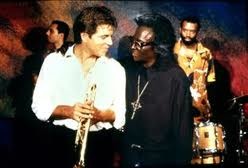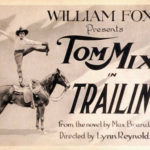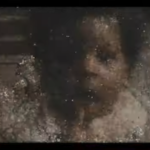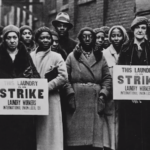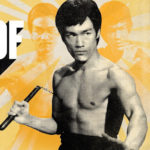Fit for a Restoration
A Trip to the Movies, at Australia’s National Film and Sound Archive
n
It’s always a great pleasure to be reminded of what makes for a successful film restoration.
For starters, of course, it’s one that recovers films from obscurity, neglect, or the undersides of history’s high-piled dust heaps. Most viewers of restored films little suspect the technological challenges and technical skills involved in the process; technicians’ accomplishments – sharpened light, more vivid colour, repaired tears and hiatuses – obviously are crucial in renewing earlier impressions of a film, and in sparking new perceptions.
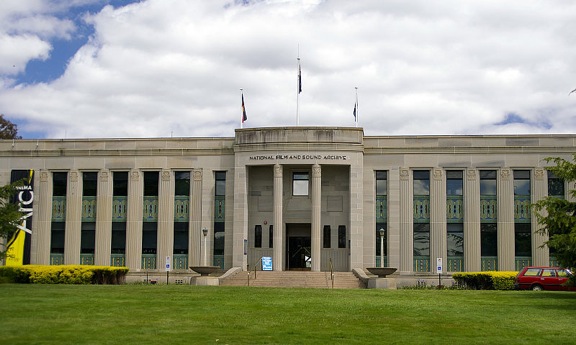
n
But nothing helps a fresh print provoke eye opening or re-opening like viewing it in a stylish theatre with crystal-clear sound. A well-restored print may be even more moving than the grainy, worn one that somehow made its way, years ago, to a lecture hall at a university that aficionados put into service as a movie house, a couple of evenings each week.
The other day, I visited Australia’s National Film and Sound Archive, in Canberra, for a matinee of Rolf de Heer’s 1991 sleeper, Dingo, the only feature film that Miles Davis appeared in. His charismatic vitality plays a key role in the film, even though he was near his death.
The National Film and Sound Archive had commissioned a preservation print as part of a project that wrapped up two years ago. In an 11-year collaboration with Deluxe Sydney and Kodak Australasia, the Kodak/Atlab Collection (2000-2005) and the Deluxe/Kodak Collection (2006-2011) preserved and made publicly available 75 colour feature films made in Australia between the 1950s and 90s. The resuscitated films include some likely to be known by few Australians, let alone anyone outside the country. Ever heard of Jim Sharman’s 1978 film from Patrick White’s scourging satire of social climbing,The Night the Prowler? Or Jocelyn Moorhouse’s outstanding Proof (1991), an urban parable in which Hugo Weaving’s character’s blindness encounters the ready roughness of a younger man, played by a promising Melbourne actor, Russell Crowe.
Also in the collection are some films well known beyond Australian shores, such as Peter Wier’s Gallipoli (1981) and Jane Campion’s The Piano (1993), which serve as reminders that even commercially successful films may need some loving care, too, if they are to survive.

As all that suggests, the film’s sound, music, and look would be vital elements in any restoration. That only makes sense, given the action of the film. It is fundamentally about how music and a vision of a larger life captivate the mind of a boy in an outback town.
One day in 1969, the residents of remote, dusty Poona Flat are startled to hear a plane approaching. A 707, certainly larger than anything the runway has ever borne, or conceivably could, drops from the sky and the craft looms across the dirt runway. It pulls up right in front of the shack that resembles a sheep shed and is about all there is of the tiny, fenceless Poona Flat airport other than an expanse of drought-parched dirt.The cargo bay opens. There, in all unlikelihood, stands Billy Cross (Miles Davis) and his octet, their leader in oversized shades and decked out in the colourful but dark, don’t-mess-with-me fashions that Davis favored during the second half of his career. The rest of the combo is hipper than anything Poona Flat has ever seen, or ever will again.
Billy Cross is a barely disguised version of Davis. His band plays, on screen, just one sizzling number as the townspeople look on, shuffling closer but not too close – none except John Anderson, 9 (Daniel Scott), who steps close, drawn by the band’s uncanny, utterly otherworldly sound. The rhythm section thrums and sizzles behind Davis’s transfixing blare.
It’s all as if in a dream. Indeed, the plane seems an alien craft that has landed for no particular purpose. Cross lingers, asks little John Anderson: “Did you like the music?”
He replies: “It was the best thing I ever heard.”
As the boy pleads that the epiphany not dissolve, Cross looks at him with that deep portal to Davis’s imponderable soul: “If you ever come to Paris, look me up.”
It’s a moment as moving as any in a jazz film, although Dingo is not really that. Or, at least, it is far more. The boy’s future is forged, there, in that vision. We next see him 20 years later, now “Dingo” Anderson (Colin Friels). A family man more at ease in the bush, he blats and whinnies his own trumpet to the seared expanse of grazing land and scrub where he scratches for a living as a trapper of dingoes that have harassed his neighbors’ flocks. One of the wild dogs, in particular, vexes him – a “well-educated” dingo that knows how to spring a trap.
Dingo does make it to Paris, in circumstances, and with outcomes, as unpredictable as that first flight into Poona Flat.
Rent the film; guaranteed. Better still, bring it to a large repertory screen with superior sound, near you.
For the Australian-French production, de Heer secured the services of Davis knowing little about him other than his fearsome reputation. (Has any autobiography before or since so liberally and often employed the word “m……….r”?) De Heer recalled in 1991: “I was wary of the potential problems right from the start. I realized casting Miles would either make or break the film, both financially and artistically.”
Hardly one to attach his name to anything that would be a loser, Davis told the director that he would score the film with the legendary composer Michel Legrand, and aim to “rediscover the sound, the ambience of my cool period, the style of Kind of Blue, Sketched of Spain, and Milestones.” Friel bravely mimics a trumpeter, but American session player Chuck Finley superbly renders his parts.
Davis, said de Heer, “turned out to be a wonderfully instinctive actor. When he wasn’t in the moment as his character, he forgot the dialogue. This made it impossible for him to be bad. Most of the time, he was ‘in the moment’ and very good. He was extraordinary, wonderful to work with. Like any actor, not always easy, but much, much easier than we expected.”
Thanks to Davis’ and Legrand’s contributions, and those of the heavyweight bands that Davis had for the project, the film’s soundtrack has fared well. Still fresh – riveting, in fact – it remains in print and highly regarded, 44 years later.
Box office receipts were never good. The film cost $5.6-million, but recouped only $132,500 from domestic box offices; video and DVD sales and rentals continue to produce a trickle of revenue, but by accounting measures, the film flopped.
Dingo’s screenwriter, Marc Rosenberg, arrived in Australia as a young man at the end of round-the-world travels, and came to film by way of a writing program at the Australian Film and Television School, the country’s premier institution for film training. His fellow students included Jane Campion and P.J. Hogan (Muriel’s Wedding, 1994). Soon after he graduated in 1982, he worked with Phillip Noyce on the script for Heatwave, which starred Judy Davis. (It tells of an ex-con who encounters bizarre events – birds falling dead out of the sky, people going suddenly nuts, that kind of thing.)
Rosenberg’s first solo credit was the 1988 feature, Encounter at Raven’s Gate, the second feature film de Heer made; Dingo would be de Heer’s third, and Rosenberg’s, too.
Before settling in Los Angeles, Rosenberg went on to write three more scripts including one for December Boys (2007), which starred a youngish Daniel Radcliffe and was Australian director Rod Hardy’s third feature film among 40 years of active television scriptwriting.
The Dutch-born de Heer came to Australia in 1969 from Singapore, via a refugee camp, with his family. His career has been an idiosyncratic one, in many senses, among them that he has seemed never to stumble over a desire to register a commercial hit. Among his recent projects is an online-only collection of audiovisual renditions of Aboriginal tales, 12 Canoes. It was a sequel of sorts to his truly extraordinary feature 10 Canoes, the first feature film made entirely in Australian Aboriginal languages.
Dingo stands as a kind of early statement of intent for de Heer, a credo. He has described it as a “human drama about fulfillment of dreams and the avoidance of regret.”
Anyone familiar with films like 10 Canoes would certainly regret the nightmare of Dingo gradually deteriorating into oblivion as so many films do.
The proof of a restoration project is in the viewing, and here is where the National Film and Sound Archive provided an essentially fillip: fine projection, and superb sound.
n
nn
 The Archive occupies what was formerly the Australian Institute of Anatomy, at the edge of the Australian National University in the nation’s capital city – the “bush capital.” The building was completed in 1930, as one element in the city’s original grand plan – that of American architect and landscape architect, Walter Burley Griffin, an acolyte of Frank Lloyd Wright and the Prairie School of American design. For the Institute of Anatomy, the Federal Capital Commission called on a leading Australian architect, Walter Hayward Morris. His brief was to create a fitting home for the anatomical collection of a noted scientist, Sir Colin MacKenzie.
The Archive occupies what was formerly the Australian Institute of Anatomy, at the edge of the Australian National University in the nation’s capital city – the “bush capital.” The building was completed in 1930, as one element in the city’s original grand plan – that of American architect and landscape architect, Walter Burley Griffin, an acolyte of Frank Lloyd Wright and the Prairie School of American design. For the Institute of Anatomy, the Federal Capital Commission called on a leading Australian architect, Walter Hayward Morris. His brief was to create a fitting home for the anatomical collection of a noted scientist, Sir Colin MacKenzie.
When the National Film and Sound Archive was created in 1984, it moved into the building. The archive’s functions had until then been handled by two other Australian institutions: the National Library and the National Archives.
Now heritage-listed, the NFSA’s home is a building of Late 20th Century Stripped Classical style and has some of the finest examples of Australian Art Deco design. Those include simplified, modern echoes of ancient Greek and Roman architecture, such as a symmetrical façade and classical columns.
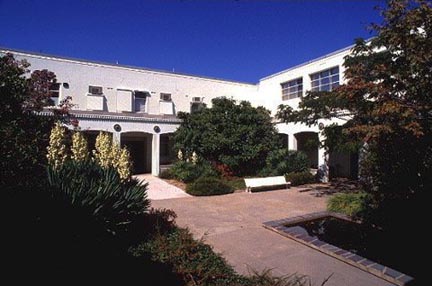
The approach to the facility is a short flight of wide red-granite stairs leading to a front entrance between blue, yellow, and green tiled panels inspired by Aboriginal bark paintings of frilled-neck lizards and boomerangs. Aboriginal art also informs the marble floor within the entrance. Many motifs of Australian animals are scattered around the facility: goannas on capitals, frilled lizards on door surrounds, wombats in roundels, and, on pilasters, plaster castings of kookaburras, tree kangaroos, koalas, wombats, and platypuses.
Platypus designs appear throughout the building, as Sir Colin MacKenzie believed the ancient monotreme was the link between mammals, birds, and reptiles. It wasn’t, but the NFSA building reminds visitors of the link – at least, those who look up to a large, stained-glass skylight with stylized platypus.
Geometric Art Deco patterns are seen throughout the building – even in suspended lights, heating ducts, and air vents. Floors are laid with tiles and polished tallow wood. Along the walls are molded impressions of famous scientists, two made from death masks. MacKenzie’s ashes are behind a commemorative plaque.
Also prominent in the entrance’s floor and columns is black marble quarried from Acton Flats, a long stone’s throw away – the government department my dad worked for had its Christmas parties there until 1962, when the whole area was flooded to construct the first of the city’s now umpteen artificial lakes and ponds.
I remember well those annual gatherings in the rising summer heat of Decembers. We had running races. Each kid got a gift. Someone organized to bring in ponies.
Sadly, Miles never did make an appearance.
nn
 He did, however, at the NFSA theatre, the other day. His image, whether in the guise of Billy Cross, or not, was a stirring reminder of his vast contributions to American and world culture – of how he could inspire countless jazz musicians, as little Dingo Anderson. Most rousing – of reminiscences of his playing at the time Dingo was made, and of his resounding peals through more than four decades – was Miles Davis’s music as brought alive by ideal technologies in the NFSA facility. Construction of the 250-seat screening venue began in 2006 after NFSA directors decided that they could no longer tolerate having a headquarters building without a dedicated, state-of-the-art screening room. They decided to sacrifice one of the building’s two-story exhibition halls to the cause.
He did, however, at the NFSA theatre, the other day. His image, whether in the guise of Billy Cross, or not, was a stirring reminder of his vast contributions to American and world culture – of how he could inspire countless jazz musicians, as little Dingo Anderson. Most rousing – of reminiscences of his playing at the time Dingo was made, and of his resounding peals through more than four decades – was Miles Davis’s music as brought alive by ideal technologies in the NFSA facility. Construction of the 250-seat screening venue began in 2006 after NFSA directors decided that they could no longer tolerate having a headquarters building without a dedicated, state-of-the-art screening room. They decided to sacrifice one of the building’s two-story exhibition halls to the cause.
They entrusted design to Santa Fé-based theatre designer and artist Garry Transue. On a 2006 visit to Canberra, he handed a rough-sketched plan to Paolo Chechi Usai, the NFSA’s director at the time, renowned worldwide in film-archiving circles. His proposal consisted of two A2 leafs of sketch paper bearing decorative designs and text. Transue explained why he thought “Arc” would be a suitable name for the theatre: “Arc, short for archives, describing a trajectory – a path of conductivity from past to future, from old to new, known to unknown, from where the NFSA has been to where it is headed. An arc occurs between two poles and creates a bridge of current. The name also refers to projectors of old which used carbon arc light sources. Arc is short and succinct, suggesting a charged environment, full of energy and the spark of creativity.”
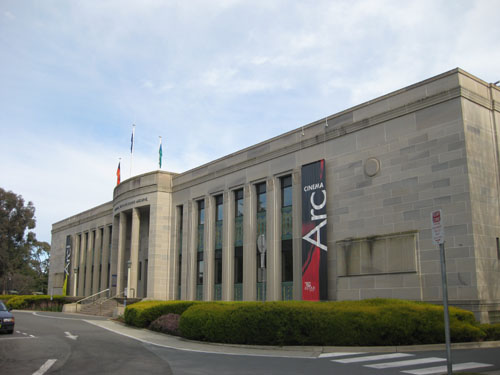 He went on to detail superb projection and sound systems, as well as Art Deco-inspired house lighting. Here are details (for the techies): Arc’s projection booth is fitted with 35/16 mm changeover projection, using a pair of custom-designed, adaptable Kinoton projectors. They are amongst a handful of projection systems in Australia capable of screening all manner of historic and contemporary images in a wide range of aspect ratios, with the ability to run silent films at correct speeds. This archival film-projection system permits NFSA to screen rare prints from its own collection and also from libraries and archives around the world.
He went on to detail superb projection and sound systems, as well as Art Deco-inspired house lighting. Here are details (for the techies): Arc’s projection booth is fitted with 35/16 mm changeover projection, using a pair of custom-designed, adaptable Kinoton projectors. They are amongst a handful of projection systems in Australia capable of screening all manner of historic and contemporary images in a wide range of aspect ratios, with the ability to run silent films at correct speeds. This archival film-projection system permits NFSA to screen rare prints from its own collection and also from libraries and archives around the world.
To this end, Arc also boasts a variety of video and digital formats, enabling it to screen video up to high-definition and back to video’s earliest days.
Similarly, Arc’s sound system can handle many audio formats, from the earliest days of sound on film to state-of-the-art digital audio. It can provide reinforcement for live accompaniment to silent films.
The NFSA website provides these specs:
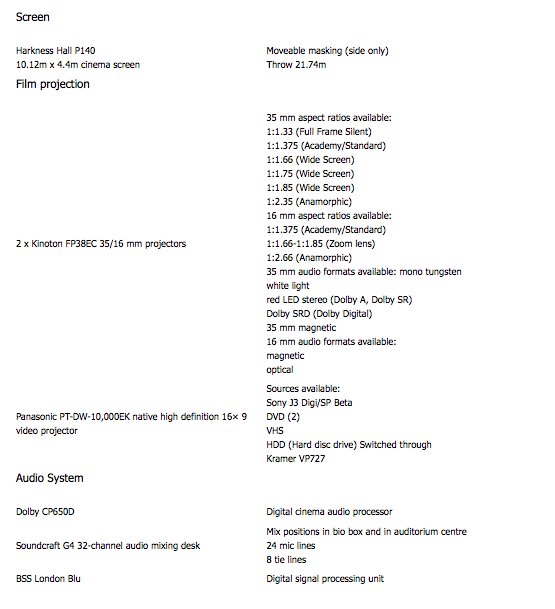
All that ensures sound far better than Dingo Anderson would have heard it, through the dust kicked up as he and his fellow residents of Poona Flat rushed to witness so rare an event, on that fateful afternoon. But he was, of course, hearing something more than natural sound: some sort of celestial utterance. And he lived not to regret it.
Previous Post: When Women Made the Movies
Next Post: Video of the Day: Sing and Sling


